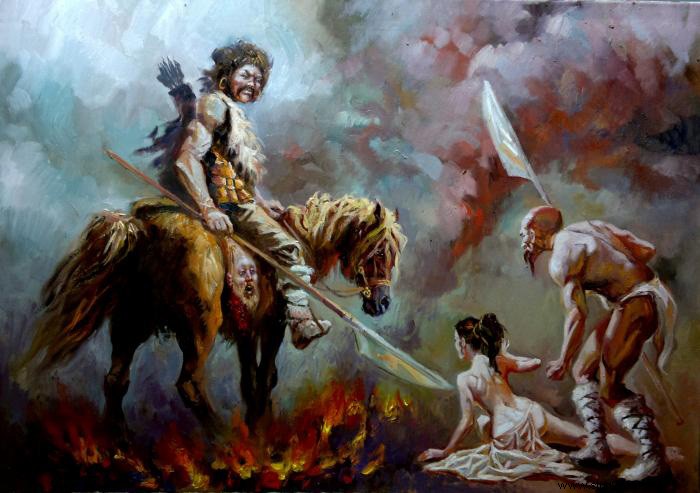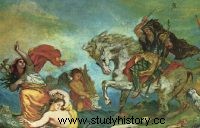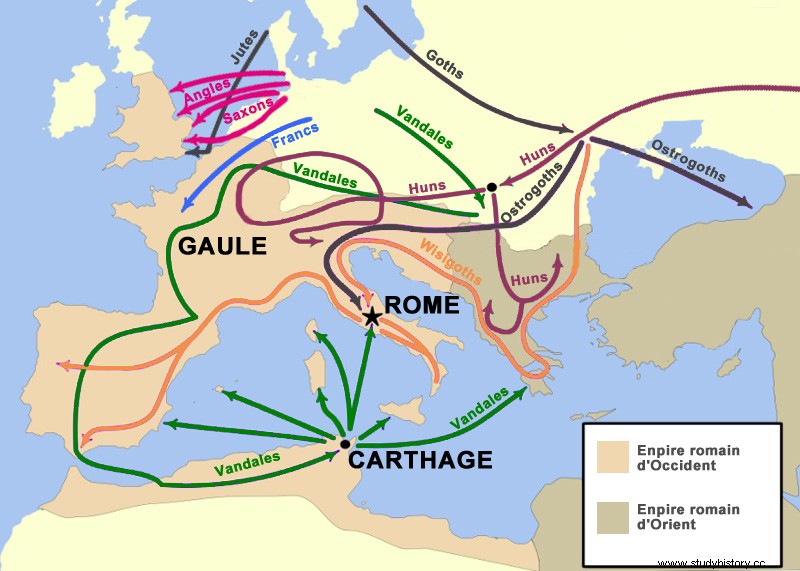The Romans named “barbarians ” the warlike tribes outside their empire who came from the Northeast to invade them. Barbarians swept through Europe destroying the Roman Empire, and around 500 they created their own independent kingdoms. They know how to work metal with skill and are excellent warriors. Most are pagans, that is, non-Christians. Wherever they settled, the churches were abandoned and around 500, Christianity practically disappeared from the countries of Europe.
Origins of the Barbarians:
The Visigoths, The Ostrogoths , the Vandals, the Angles, the Saxons, the Franks, the Suevi , the Burgundians and the Jutes are from Germanic peoples.
The Huns come from Central Asia.
The Alans are a descendant of the Scythian people (The Scythians).
EN 406
The Vandals:
After the great invasion of 406 in Italy, the Vandals engaged in a systematic looting of Gaul for 2 years, then settled in Spain.
EN 410
The Visigoths become the masters of the kingdom of Aquitaine:
After seizing Rome, the Visigoths headed for Gaul, and their king Athaulf set up his command center in Bordeaux. At the request of the Roman Emperor Honorius, they clean Spain of the Vandals, the Sweves and Alans. In compensation, they obtain the right to settle in the south-west of Gaul and become the masters of all of ancient Aquitaine. Theodoric I is the first Visigoth sovereign of this state, whose capital is Toulouse.
The Vandals become the Pirates of the Mediterranean:
At that time, the Vandals had Genséric as king, one of the great figures of the Germanic world. This gives them a new vocation, that of pirates of the Mediterranean.
EN 429
Kingdom of the Vandals in North Africa:
The Vandals ravage everything in their path and seize Hippone, Cirta and Carthage after a long resistance. They then seized the Balearic Islands, Corsica, Sardinia and Sicily. Around 470, the Mediterranean Empire of the Vandals included North Africa and the Mediterranean islands.

In 434
Beginning of the reign of Attila, king of the Huns:
The Huns come from Central Asia and they sow terror with their cruelty and savagery. King Attila governs all of the Hunnic hordes after getting rid of his brother Bleda by murder. Attila's fierce reputation earned him the nickname "Scourge of God" and he flattered himself that even "the grass does not grow back where his horse has gone".
Anecdote :At the end of the 4th century, the Latin writer Ammien Marcellin describes the panic aroused in the lands invaded by these little black men, dressed in rats' skins and "studded" on their horses on which they eat, drink and sleep.
EN 443 – 448
Attila the Hun directs his ambitions to the East, then to the West:
His soldiers arrive as far as Constantinople, then sink into Greece. However, without the reason being really known, Attila abandons the East to turn to the West.

In 451
Attila on the assault of Gaul:
Attila the Hun crosses the Rhine, destroys Metz, Reims, Troyes and terrorizes the Gauls with his murderous raids. Paris seems threatened and its inhabitants are preparing to flee, but a young girl, Sainte Geneviève, future patroness of the city, calls them to resistance. Attila the Hun bypasses Paris and besieges Orléans, the capture of which should allow him to advance into the kingdom of the Visigoths. But he was stopped in his march and pushed back out of Orléans by an army made up of Romans, Franks, Alans and Burgundians , compiled by the Roman Aetius with the help of Theodoric I, Visigoth King of Aquitaine. In June 451, west of Troyes, Aetius and Theodoric, after an atrocious battle, forced the Huns to withdraw towards the Rhine. Gaul is saved.
In 452
Attila the Hun sets out to conquer Italy:
Attila the Hun seizes Aquileia, Milan, Padua, Pavia and Ravenna then tries to seize Rome, but ends up leaving in exchange for a heavy tribute.

In 453
Death of Attila the Hun:
No sooner had he returned to his kingdom than Attila the Hun died on his wedding night, probably of aploplexy . His empire did not survive his disappearance and the Huns fell back towards the Black Sea. They leave behind a reputation as cruel savages, yet they are the first barbarians to be stopped on their march west. It is also the first time that Romans and Germans , driven by a common “European” force, unite to repel an invader.
Between 476 and 500
The kingdom of the Visigoths expands and includes a large part of Gaul, Spain and Portugal:
After the death of Theodoric I in 451, his sons Theodoric II and Euric enlarged the kingdom of the Visigoths, which eventually extended from the Atlantic to the Southern Alps, and from the Loire to Gibraltar (southern Spain). Only the northern part of Portugal and Galicia (occupied by the Suevi) is not under their control.
In 711
The kingdom of the Visigoths is conquered by the Umayyad Arabs Muslims .
Learn more about the Romans during antiquity.
